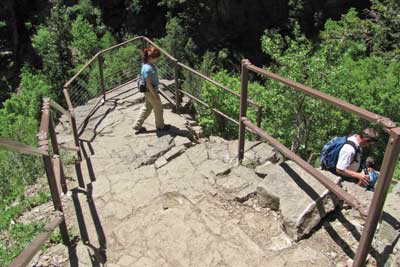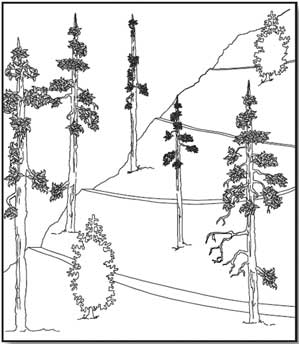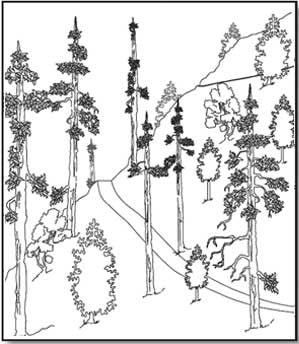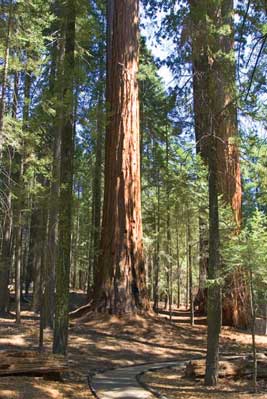Conditions for an Exception in FSTAG
FSTAG is based on the realities of the outdoor environment and recognizes that complying with accessibility provisions is not always practicable because the natural terrain, existing vegetation, or other constraints impose limitations in some locations. To ensure that the unique characteristics of the outdoor environment and trail recreation opportunities aren't compromised or fundamentally altered, exceptions and deviations from some technical requirements are permitted when certain circumstances, called conditions for an exception, apply.
The following paragraphs explain the four conditions for an exception identified in section 7.1 of the FSTAG. Circumstances under which deviations from the technical requirements are allowed based on the conditions for an exception differ depending on the setting. The four conditions for an exception are the basis for permitting deviations from specific technical requirements when allowed by General Exception 1 or General Exception 2, as explained in "General Exceptions in FSTAG."
Conditions for an exception are not blanket exemptions from all of the technical requirements for an entire trail. If a condition for an exception occurs only on part of the trail or trail component, the technical requirement applies everywhere else. All technical requirements not affected by the condition for an exception also apply. This requirement is explained in "General Exceptions in FSTAG."
The conditions for an exception cover all the important elements of a long-distance trail and the aspects that are considered when locating trail segments, but they shouldn't be used as an excuse or loophole for failing to make trails accessible. Rather, they are to be used when all other design options have been thoroughly explored and a determination has been made that full compliance with the technical requirements would unacceptably alter the nature of the experience the visitor is seeking or unacceptably impact features that are protected by law.
The wording of each exception is brief. General examples for each exception are provided to help explain the intent of the conditions so that designers understand how to apply them according to the site-specific constraints and opportunities of their projects.
Condition for an Exception 1. Where compliance with the technical requirement is not practicable due to terrain (figure 120).

Figure 120—Compliance with the technical requirements on the trail to Hanging Lake at the White River National Forest is not practicable due to the extreme slope of the terrain.
The phrase "is not practicable" in this condition for an exception refers to something that isn't reasonable, rather than to something that is technically impractical. The intent of this condition is that the effort and resources required to comply shouldn't be disproportionately high relative to the level of access established.
Condition for an Exception 2. Where compliance with the technical requirements would fundamentally alter the function or purpose of the facility or the setting.
Public lands provide a wide variety of recreational experiences, from highly developed areas that offer plenty of conveniences and opportunities to relax with family and friends, to wilderness areas that appear unchanged from primeval times and provide opportunities for individuals to experience primitive and challenging conditions. FSTAG recognizes the value of the full range of recreation opportunities by allowing deviations from the technical requirements where compliance would unacceptably change the nature of the recreation opportunities or conflict with the land and the resource management plan for the area.
People using primitive trails, for example, experience the outdoor environment in a nearly natural state, with limited or no development. In these settings, people generally desire challenge and risk so they can use their outdoor skills. Use of manufactured building materials or engineered construction techniques to comply with accessibility provisions could destroy the natural or undeveloped nature of the setting and change the visitor's experience. FSTAG does not require that obstacles be blasted or trails paved to be more accessible if such activity would unacceptably change the character of the setting and the recreation opportunity.
Terminology Tip
What's practicable?
Using heavy construction equipment, it may be possible to provide a trail with a maximum 1:20 (5 percent) grade up a 1,500-foot (460-meter) mountain (figure 121). However, the trail would be about three times as long as under a traditional back-country layout (figure 122). The length of the trail could cause inappropriate environmental and visual impacts and more than triple the amount of ground disturbed. It wouldn't be practicable to construct a trail in compliance with technical accessibility requirements.

Figure 121—A trail with a 5-percent grade on a steep hill.

Figure 122—A traditional trail layout for a steep hill.
Consider a trail intended to provide a rugged experience, such as a cross-country training trail with a steep grade or a fitness challenge course with abrupt and severe changes in elevation. If these trails were flattened out or otherwise constructed to comply with the technical accessibility requirements, they wouldn't provide the desired challenge for users. Trails that traverse boulders and rock outcroppings are another example. The purpose of these trails is to provide users with the opportunity to climb the rocks. To remove the obstacles along the way or reroute the trail around the rocks would destroy the purpose of the trail. The nature of the setting also may be compromised by actions such as widening a trail for an imported surface or removing vegetation from fragile or erosive soils.
Condition for an Exception 3. Where compliance with the technical requirements cannot be accomplished with the prevailing construction practices.
This condition for an exception may apply when the construction methods needed to comply with a technical requirement would require the use of equipment or methods other than those typically used in that setting. For instance, in an area where small equipment is normally used to minimize impact on a sensitive adjacent stream, blasting might be necessary for rock removal to meet the technical width requirement for a trail. Because blasting typically would not be used in this situation, this condition for an exception would apply. If the work could be done using small equipment, this condition for an exception wouldn't apply.
This condition for an exception is not intended to exempt the trail from the technical requirements of FSTAG simply because a trail builder's favorite construction practice (such as the use of a large mechanical roller rather than a smaller vibrating plate or "whacker" type compactor) is inappropriate or impractical. A contractor's or designer's preference for different equipment is not a prevailing construction practices issue. A deviation from a specific technical requirement only can be allowed if the equipment is essential to complete the construction in that location.
Condition for an Exception 4. Where compliance is precluded because the cultural, historic, or significant natural features are protected or are eligible for protection under Federal, State, or local law by:
-
Endangered Species Act (16 U.S.C. 1531 et seq.)
-
National Environmental Policy Act (42 U.S.C. 4321 et seq.)
-
National Historic Preservation Act (16 U.S.C. 470 et seq.)
-
Wilderness Act (16 U.S.C. 1131 et seq.)
-
Other Federal, State, or local law (the purpose of which is to preserve threatened or endangered species; the environment; or archaeological, cultural, historical, or other significant natural features)
Cultural features include archeological sites, burial grounds and cemeteries, traditional cultural properties, tribal protected sites, and other properties considered sacred by an organized religion. Historical features are properties listed or eligible for listing on the National Register of Historic Places or other places of recognized historic value. Significant natural features are objects that are regarded as distinctive or important locally, regionally, or nationally and, therefore, have been placed under legal protection, such as a large boulder or rocky outcrop, body of water, or unique tree or vegetation such as a giant sequoia grove (figure 123). Areas that are legally protected include wilderness areas designated by Congress and areas protected under Federal or State laws, such as habitat for threatened or endangered species or designated wetlands.

Figure 123—The Long Meadow grove of giant sequoias is an example of a significant natural feature.
Situations when this condition for an exception may apply include these examples:
-
Where use of mechanized equipment is prohibited by law, such as in wilderness areas designated by Congress, and work necessary to comply with a technical accessibility provision can't be accomplished using handtools
-
Where imported materials, such as soil stabilizers, are prohibited to maintain the integrity of a natural ecosystem or historic resources
-
Where construction methods and materials are strictly limited to protect designated wetlands or coastal areas
-
Where the physically undisturbed condition of the land is an important part of a sacred observance, such as at tribal sacred sites
-
Where water crossings are restricted to safeguard aquatic features or species protected under Federal or State laws
The Federal laws specified in Condition 4 prescribe certain activities or require certain analyses or procedures to be followed when planning projects that may impact features protected under those laws. This condition for an exception applies when it is determined that the actions, required analyses, or other impacts necessary to meet the technical requirements would directly or indirectly substantially harm the protected feature.
Design Tip
Determine the extent of impact.
Only consider the additional impact of increasing the width, reducing the trail grade or cross slope, or other change required for accessibility. For example, consider a trail project that crosses a hill where a population of wildflowers of an uncommon species is growing. The surrounding river drainage and a nearby town are named for the plants. The trail construction will destroy most of the flowers, as well as the seep-dampened hanging meadow that provides their habitat. Condition 4 wouldn't apply if 323 square feet (30 square meters) would be disturbed to construct a trail that is not accessible and only an additional 75 square feet (7 square meters) would be disturbed to construct a trail that meets the technical accessibility requirements. The majority of the proposed damage to the wildflowers is not attributable to compliance with accessibility requirements. In this case, an alternate location should be selected for the trail.

User Comments/Questions
Add Comment/Question